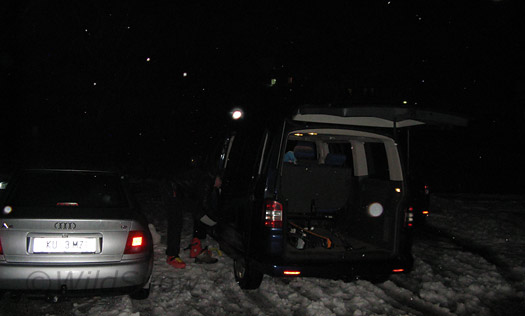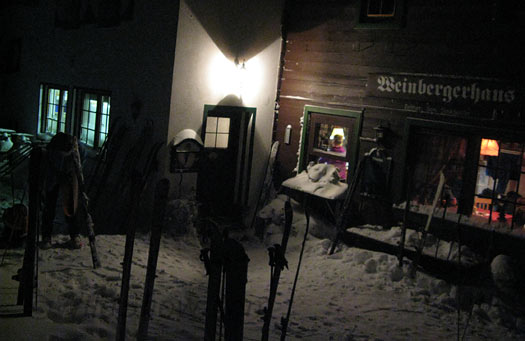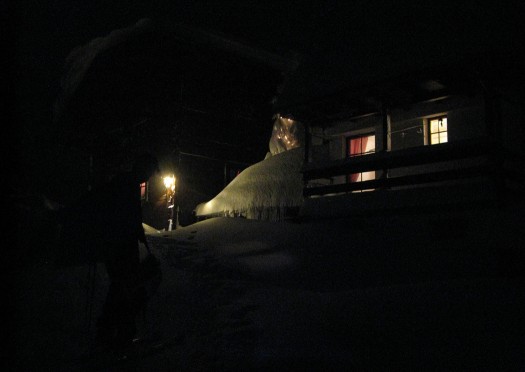Kufstein, Austria. The skiers around here don’t mess around with their fitness. Cardio nearly every day is the rule, and it doesn’t have to be in the backcountry. Uphilling the slackcountry on skis is incredibly popular, with many people heading out in the evening lit by headlamp. What seems to help the situation is having numerous places where you can ski up to a restaurant, hang out for a moderately priced meal, then glide down to your car and head home. Weinbergerhaus near Kufstein, Austria is one of hundreds such places. I headed up there the other night with Franz Kroel from Ortovox, expecting a few beers and some beacon tech talk. Franz most certainly delivered in both departments.

For this jaunt you park at resort slopes with a lift that's closed most of the season. Enough people head up here to keep three resturants in business, with the top and most authentic alpine option being Weinbergerhaus. Franz arrived with a pair of vintage red Dynafit Tourlite boots, he tours quite a bit, so I marveled at how he'd not worn out the toe fittings. Light on his feet.

Winbergerhaus backcountry skiing.
Avalanche beacons were the topic during this mission, and during subsequent backcountry powder the next day. Franz had a previous career as a top guide. He’s also known as a pioneer climber with routes to his credit that are still unrepeated due to his ethic of using only natural protection. If you’re an Austrian guide and climber, that means your DNA is infused with ski alpinism. Thus, perfect guy to be working with Ortovox since 1991 on product development and marketing.
Probably the most interesting part of our conversation regarded the emergency return to transmit feature that nearly all beacons now have. Several years ago when this feature was furiously debated. Franz was vehemently against it, as was I. Reason being that before the days of beacon sophistication (dealing with multiple signals) an extra transmitting beacon could dangerously delay a search due to signal confusion. Since than, several things occurred that changed opinion and proved that emergency transmit return is an acceptable if not necessary feature.
First, as automatic return-to-transmit permeated the market, so did better functions for dealing with multiple signals. That alone could have made the issue moot. But a few years ago a Swiss rescue team on a mission was nearly wiped out (I recall it was seven dead) because they had the optional transmit return disabled on their avalanche transceivers when they were buried in a slide. Franz said analysis indicates at least half of them would have been recovered alive if their beacons had been transmitting. This event alone made the point that return-to-transmit was important if not essential — and should be left enabled. Adding to all that, now the automatic transmit is coupled with the movement detector in beacons such as certain Ortovox and Barryvox models, and they don’t return to transmit unless sitting still (as on a buried person).
So, Franz was wrong. I was wrong. Automatic return to transmit is a good feature that now works quite well due to all the technological advances in avy transceivers.
The issue of automatic-transmit-return made for an hour or two of talk, then we moved on to things like how small can they make beacons? Yeah, in the case of Ortovox they figured out how to use just one AA battery in their 3+ model, thus reducing form factor. Could that be a lithium battery? Tough to do, according to Franz, mainly because the battery strength meter gets thrown off and you’ll have no idea how much battery you have left.
The evening concluded with a nice run headlamp illuminated glide down the powdery soft stuff that’s been falling on the mountains around Kufstein for the last few weeks. A pleasure after the white ice of Colorado.

Seems like every time I think I've run out of candidates for Guess that Pastry, another comes along. This is a basic keuken made from something 'orignal,' perhaps some of you experts can get me more up to speed on the details.
WildSnow.com publisher emeritus and founder Lou (Louis Dawson) has a 50+ years career in climbing, backcountry skiing and ski mountaineering. He was the first person in history to ski down all 54 Colorado 14,000-foot peaks, has authored numerous books about about backcountry skiing, and has skied from the summit of Denali in Alaska, North America’s highest mountain.

